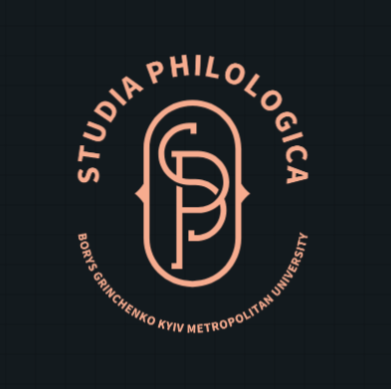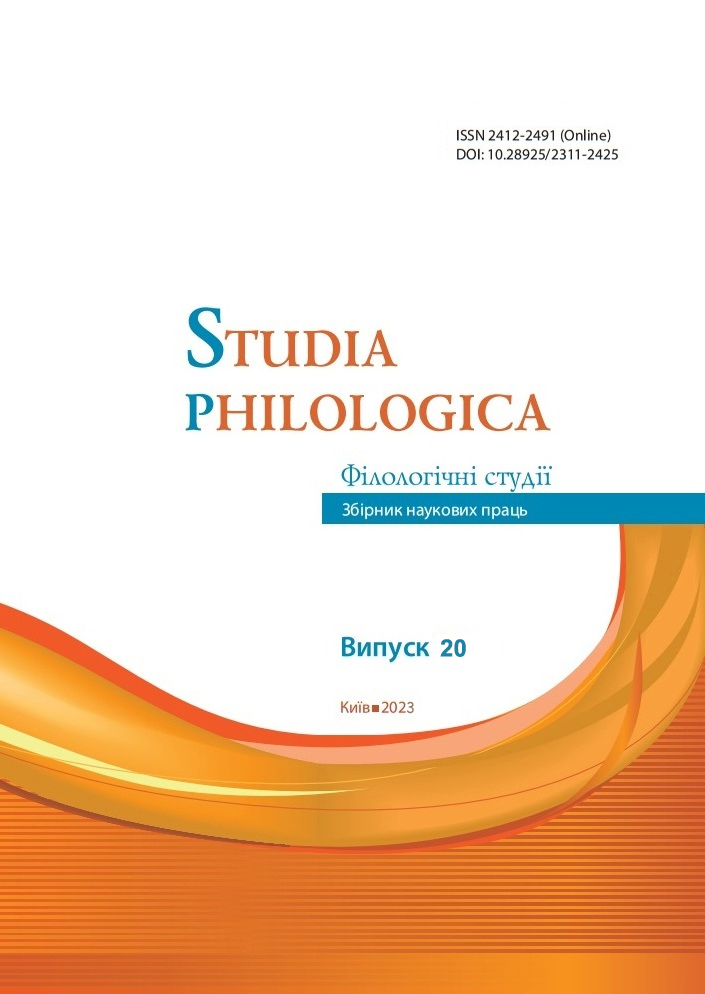Лінгвокогнітивні сценарії художнього наративу Наталі Саррот
DOI:
https://doi.org/10.28925/2311-2425.2023.22Ключові слова:
наративна структура художнього тексту, лінгво-когнітивний сценарій наративу, літературний текст періоду Нового роману, ретроспективність, фрагментарність, деталізація, кадрування наративуАнотація
Статтю присвячено дослідженню розвитку лінгво-когнітивних сценаріїв художнього наративу письменниці доби нового роману. На матеріалі аналізу романів Наталі Саррот «Enfance», «Le Planétarium» продемонстровано обумовленість обраних методів і прийомів типом оповіді та різними характеристиками тексту. Визначено, що смислоутворювальними компонентами лінгвоконтекстуальної моделі спіраль, яку покладено в основу лінгвокогнітивного сценарію наративу СПІРАЛЬ, є ретроспективність і фрагментарність оповіді. Досліджено, що до лінгвокогнітивного сценарію наративу МОЗАЇКА належать художні наративи Наталі Саррот, композиційними домінантами побудови яких є деталізація та кадрування оповідного зображення. Підтверджено припущення що, лінгво-когнітивні сценарії наративу передбачають взаємозв’язок синтаксичного, семантичного, когнітивного та семіотичного рівнів, які формують план вираження сценарної побудови романів авторки. Доведено, що лінгво-когнітивні сценарії наративу існують, якщо лексичні, синтаксичні та стилістичні одиниці утворюють сценарні схеми чи структури в тексті та породжують динаміку розвитку сценаріїв художніх текстів, а також є втіленням авторського бачення світу, переданого через використання письменниками в тексті художніх засобів і прийомів. Таким чином, для художніх текстів Н. Саррот характерна нелінійна когнітивно-наративна сценографія, яка являє собою сукупність мовно-когнітивних сценаріїв оповіді, а саме спіралі та мозаїки.
Завантаження
Посилання
Bakhtin, M. M. (1979). Aesthetics of Verbal Art. Moscow : Iskusstvo.
Barthes, R. (1966). Introduction à l’analyse structurale des récits. Communications, 8(1), 1–27.
Beaugrande, R. (1980). Text, Discourse and Process (Toward a Multidisciplinary Science of Texts). New York.
Bremond, C. (1964). Le message narratif. Communications, 4, 4–32.
Charaudeau, P. (1983). Langage et discours : éléments de sémiolinguistique : (Théorie et pratique). Paris : Classiques Hachette.
Chartier, P. (1990). Introduction aux grandes théories du Roman. Paris : Bordas.
Eco, U. (1985). Lector in fabula ou la coopération interprétative dans les textes de fiction. Paris : Grasset.
Fludernik, M. (2010). Towards a ‘natural’ narratology : Frames and pedagogy. A reply to Nilli Diengott. Journal of Literary Semantics, 39(2), 203–211. doi:10.1515/jlse.2010.012
Friedman, N. (1975). Point of view. Form and meaning in fiction. Athens: Univ. of Georgia Press. 134–166.
Genette, G. (1972). Figures III. Paris : Seuil.
Greimas, A.-J. (1966). Eléments pour une théorie de l’interprétation du récit mythique. Communications, 8, 28–59.
Herman, D. (2000). Narratology as a cognitive science. Image [&] Narrative (Online Magazine of the Visual Narrative, K.U.Leuven.
Jeandillou, J. F. (2006). L'analyse textuelle. Armand Colin.
Kindt, T. (2008). L’auteur implicite. Remarque à propos de l’évolution de la critique d’une notion entre narratologie et théorie de l’interprétation.
Lanser, S. S., (1981). The Narrative Act. Point of View in Prose Fiction. Princeton : Princeton Univ. Press.
Lotman, Y. M., & Lotman, M. Y. (2000). Semiosphere (Vol. 7). Art-SPB.
Maingueneau, D. (2021). Discours et analyse du discours: Une introduction. Armand Colin.
Mazurak, A. I. (2012). Elements of Cinema Poetry in Fiction of the Pre-cinematic Period in the Interpretation of Mychailo Romm. Scientific works of the Petro Mohyla Black Sea State University Kyiv-Mohyla Academy Complex. Series: Philology. Literary Studies, 181, 49-53. (in Ukrainian)
Minsky, M. (1974). A framework for representing knowledge.
Nünning, A. (2010). Narratologie ou narratologies ? Un état des lieux des développements récents : propositions pour de futurs usages du terme. In J. Pier & F. Berthelot (Éd.), Narratologies contemporaines. Approches nouvelles pour la théorie et l’analyse du récit (p. 15-44). Paris : Editions des archives contemporaines.
Petrilli, S. (2013). The Self as a Sign, the World, and the Other: Living Semiotics. Transaction Publishers.
Propp, V. (1968). Morphology of the Folktale: Second Edition, New York, USA: University of Texas Press. doi: https://doi.org/10.7560/783911
Ryan, M.-L. (2010). Narratology and cognitive science : A problematic relation. Style, 44(4), 469–495.
Sarraute, N. (1995). Enfance. Paris : Gallimard.
Sarraute, N. (1972). Le Planétarium. Paris : Gallimard.
Savchuk, R. I., & Tuchkova, O. O. (2020). Hyperrealism as a Literary Phenomenon in French Literature of the 20th-21st Centuries. Journal of History Culture and Art Research, 9(2), 367-380. doi: http://dx.doi.org/10.7596/taksad.v9i2.2558
Schank, R. C. (1983). Dynamic memory: A theory of reminding and learning in computers and people. cambridge university press.
Selivanova, O. O. (2006) Modern linguistics: directions and problems. Poltava: Dovkillya. (in Ukrainian)
Shirova, I. A., & Goncharova, E. A. (2018). Multidimensional text: understanding and interpretation.
Smushchynska, I. V. (2011) Fiction text as an object of linguistic-stylistic analysis. Style, 10, 159–168.
Van Dijk, T. A., & Kintsch, W. (1983). Strategies of Discourse Comprehension. New York: Academic Press.
Vorobyova, O. (2022). Multimodality and transmediality in Kamal Abdulla’s short fiction: a cognitive-emotive interface. Cognition, Communication, Discourse, (24), 91-102. doi: https://doi.org/10.26565/2218-2926-2022-24-07
Wierzbicka, A. (1992). Semantics, culture, and cognition: Universal human concepts in culture-specific configurations. Oxford University Press on Demand.
Опубліковано
Як цитувати
Номер
Розділ
Ліцензія
Авторське право (c) 2023 CC BY 4.0 DEED Attribution 4.0 International

Ця робота ліцензується відповідно до Creative Commons Attribution 4.0 International License.


